|
Thomas Parker, Limited
After leaving the E.C.C., Thomas decided to form
his own electrical manufacturing company and Thomas Parker,
Limited was the result. The idea to start the company came from
a number of enthusiastic ex-Elwell Parker employees, who greatly
respected Thomas, both as an employer and an engineer. They
formed the engineering backbone of the company and also invested
in the company.
The first directors appointed on 10th May
1894, were:
Charles Tertius
Mander, Mayor of Wolverhampton.
Thomas Graham, proprietor of the Express & Star newspaper.
William Thomas, manufacturer.
Thomas Parker.
The Express & Star of Wednesday, 23rd May,
1894 reported that a prospectus for Thomas Parker, Limited had
appeared in the advertising columns and that the company was
formed to carry on the business of manufacturing plant for
electric lighting, electric transmission of power, electric
railways, electric tramways, electro-chemical, electro-
metallurgical, and such other purposes as are incidental or
conducive to any of the above objects, and new developments and
improvements in electrical and general engineering. |
|

The location of the works.
|
The article stated that the
vendor and promoter is Mr. Thomas Parker, F.R.S.E., M.I.C.E.,
M.I.M.E., M.I.E.E., J.P. of the Manor House, Tettenhall, founder and
managing director of Elwell-Parker, Limited and for five years works
manager and chief engineer of the Electric Construction Company,
Limited.
Thomas Parker acquired the freehold of about seven acres of
land on which to build the works. It was on Wednesfield Road,
Wolverhampton, within a few yards of the Great Western, London
and North Western and Midland Railway stations. |
| The Thomas Parker dynamo that was
installed at Cragside in Northumberland by Drake and Gorham,
electrical contractors, based at Victoria Street, London.
This is an early example of
one of the company's products, dating from 1895.
Courtesy of Robin Wright,
Engineering Warden, Cragside. |
 |
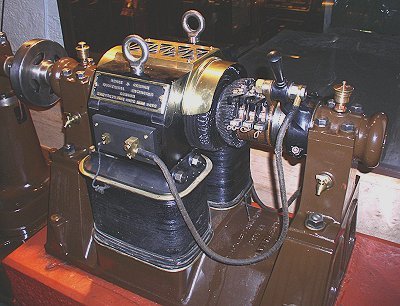 |
Another view of the dynamo at
Cragside. Courtesy of Robin
Wright, Engineering Warden, Cragside. |
|
Railway connections were sanctioned by
Wolverhampton Corporation, for a level crossing from the site of the
works towards the Midland and Great Western Railway stations. The
offices and works were within three minutes walk of the three
railway stations.
Thomas entered into a contract with the company,
dated 11th May, 1894, to act as managing director for a
period of ten years. A capital of £75,000, in 7,500 shares of £10
each, was required, of which 4,500 were quickly taken up, and the
balance of 3,000 shares were offered for subscription. The Mayor of
Wolverhampton, Alderman C.T. Mander, J.P., was chairman of the board
of directors. The temporary registered offices of the company were
at Albany Chambers, Lichfield Street, Wolverhampton.
 |
The company's factory can be seen
on the extreme left.
At the time the photograph was
taken the works were occupied by Joshua Bigwood & Sons
Limited.
Courtesy of Bill Howe. |
|
|
At the beginning of June tenders for the erection
of the works were allotted and sent out, and building work commenced
on 26th June. The buildings were erected by Mr. H. Lovatt, builder of Wolverhampton.
The first statutory meeting of the shareholders
was held on 17th August, 1894. The minutes book, records, that in
answer to a shareholder's question, Mr. Charles Mander, the
Chairman, said The purchase of the Eickemeyer Dynamo Winding
Patents had been completed, and the legal proceedings commenced by
the Electric Construction Company remained as they were, but this
board was considering the question of granting the E.C.C. the use of
these patents on terms to be agreed. The Chairman also reported
that the erection of the works was rapidly approaching completion
and that there was every prospect of the company at once entering
upon a large and remunerative business.
|

An advert from 1898.
|
|
The Eickemeyer Patents mentioned by the Chairman
were extremely important in the manufacture of armatures for dynamos
and motors, and permission to use them was essential to the E.C.C.,
who hotly disputed Thomas Parker, Limited's right to the patents.
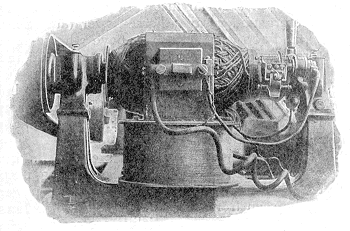
An old drum armature dynamo showing the
maze of wires at each end of the armature. |
The old style of drum armature dynamo had a
great bundle of wires crossing and re-crossing at both ends,
forming a complex maze, which was difficult and time consuming
to wire-up, and difficult to sort out under fault conditions.
This problem was resolved by Eickemeyer in about 1890. He developed an assembly
technique in which the windings were initially made on a former
and then neatly slotted into the armature. He patented the
process, but it was not generally adopted until about 1898. |
On 28th May, the Express
& Star reported that the Eickemeyer patents must be considered a
valuable property in the electrical world, judging by the struggle
to possess them. The proprietors, through their agents and power of
attorney, say that they are disposing them to Thomas Parker Limited,
and nobody else. The Electric Construction Company Limited, are
taking the means to establish their right to a license to use the
patents.
The E.C.C. published a letter regarding the
patents, in the Midland Evening News, on 22nd May , 1894
(some of the wording is a little strange):
|
The attention of my Board has been
directed to the prospectus of this company, which was
advertised on Saturday. One of the chief inducements which
is held out to subscribers is the acquisition of the
Eickemeyer Patents for winding dynamos; but the prospectus
makes no mention of the fact that these patents are in Mr.
Parker’s hands – subject to a general license in favour of
my company for the whole of the United Kingdom. The
statement in the prospectus that “Mr. Parker and his staff
designed and superintended” certain works is misleading, as
only a portion of our staff employed upon the works in
question has joined Mr. Parker since the Board of my company
dispensed with his services. We have reason to believe that
we shall have to claim certain of the other patents which it
is represented on the prospectus will be transferred to the
proposed company, as having been taken out by our employees.
The whole matter has been placed in the hands of our
solicitors, Messrs. Linklater and Co.
Your obedient servant,
By order of the Board
James Grey
The Electric Construction Company Limited, Queen Street
Chambers, Queen Street, London, E.C.
21st May 1894 |
|
The Eickemeyer Company published their reply in
the Express & Star on Friday, May 25th, 1894:
|
To publisher Express & Star,
Wolverhampton.
Sir, - Re Thomas Parker Limited. Please
insert in tomorrow’s issue a copy of the wire just received
by me,
Robert Willcock, Solicitor, 49 Queen
Street, Wolverhampton.
Thomas Parker Limited
The Electric Construction Company Limited
hold no general or any license whatever to USE the
Eickemeyer patents, or any of them. The only persons
entitled to use such patents, so far as winding is
concerned, are the Eickemeyer Company, who have agreed to
assign same to Thomas Parker.
A. Macdonald Blair, 5 St. James’s Square,
Manchester.
Solicitor for
the Eickemeyer Company and Mr. Giles Atherton, their
Attorney. |
|
The E.C.C. responded with a letter in
the Midland Evening News:
|
To the Editor of the Midland Evening News
Sir, - Re Thomas Parker, Limited. My
Boards have taken note of the wire from Mr. A. McDonald
Blair and Mr. Giles Atherton, which appears in your paper on
the subject of the Eickemeyer patents. I am instructed by my
Boards to say that they have directed Messrs. Linklater &
Co. to issue a writ against Mr. Thomas Parker and Thomas
Parker, Limited, to establish our rights. – By order of the
Board, I am, Sir, your obedient servant,
The Electric Construction Company, Limited.
James Gray, Secretary
|
|
The following day a further letter appeared
in the Express & Star:
|
Re Thomas Parker, Limited.
My Board have taken note of the wire from
Mr. A. McDonald Blair and Mr. Giles Atherton, which appears
in your paper on the subject of the Eickemeyer patents.
I am instructed by my Board to say that
they have directed Messrs. Linklater & Co. to issue a writ
against Mr. Thomas Parker and Thomas Parker, Limited, to
establish our rights.
By order of the Board.
I am Sir, Your obedient servant, James Gray, Secretary. The
Electric Construction Company Limited. Queen Street
Chambers, Queen Street, London, E.C. |
|
The dispute was eventually resolved and the
E.C.C. paid £2,000 to Thomas Parker, Limited, for the right to use
the patents.
|
|
Registration of the New
Company
The company was registered with a capital of
£75,000 divided into 7,500 shares of £10 each, on Tuesday, 13th
November, 1894.
Its object was to carry on business as electrical
and mechanical engineers, and electricians, and as manufacturers of
electrical appliances and apparatus of all descriptions.
There were
to be not less than three, nor more than seven directors;
qualification, £1,000.
|
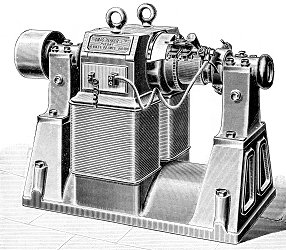
One of the company's dynamos.
|
| The Express & Star reported on the progress of
the new works, on 13th November. The article stated that the
erection of the new premises belonging to this company was
nearing completion and that the works will soon be in full
operation. Building work has gone on without interruption,
though the work of laying the floors of concrete and wood blocks
has taken some considerable time. The huge machinery was fixed
on the bed plates, and Mr. Parker, the managing director, was
well pleased with the progress generally of the works. Already a
sufficient number of orders had been secured to start the works
and employ a considerable number of hands. A range of offices
was also to be built to replace the temporary office in
Lichfield Street. |
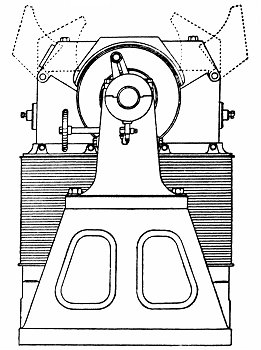
The side view of a Thomas Parker dynamo
showing the folding pole pieces, which allowed the armature to
be lifted out for maintenance. |
The new works
The new works were
officially opened on Monday, 10th December, 1894. There were
erecting, fitting, pattern, and machine shops, and a foundry for
brass and ironwork.
The building at the left of the entrance was set
apart for the erecting, fitting and machine departments. It had four
150ft. long bays, two with a span of 32ft., and two with a span of
42ft. 6 inches, all complete with travelling cranes. The iron
columns which carried the roof also supported the rails for the
travelling cranes.
In the first bay were the main engines for
driving the whole of the works, and for testing the machinery before
it was sent out. The steam for the engines was supplied by two large
Babcock & Wilcox boilers.
In the second bay were the larger tools,
general erecting and testing machinery. The third bay was the
machine shop, with lathes, milling machines, drilling machines, and
general tools used for carrying out work of any size. The fourth bay
was for light brass work, winding armatures, and other portions of
machinery.
|
|
The building had a concrete floor with wood blocks and a railway track
connected with the Midland Railway Company’s sidings. The machinery
was of an exceptionally fine description, with the latest
improvements and every arrangement to secure accuracy and rapidity
in working. The building was heated with steam from the main boilers
and radiators. The travelling cranes and machinery were driven by
motors supplied with electric current from one main dynamo, which
also supplied the electric light for the building. |
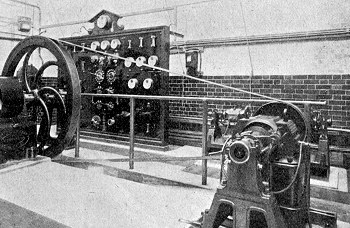
The 12 Kilowatt Thomas Parker, Limited dynamo,
that was installed at the National Physical Laboratory. |
|
The foundry building was 120ft. by 40ft., and was
complete with a ten ton, electrically fitted, travelling crane.
There was a large cupola placed in a convenient position, with a
covered stage, and a hoist for taking up pig iron, coke etc.
The pattern shop was 80ft. by 40ft. with a
concrete floor, over which wood blocks were laid. It was heated by
steam radiators. Mr. A.P. Brevitt, of Wolverhampton, was the
architect, and Mr. Henry Lovatt, the builder. Messrs. Heenan and
Froude, of Manchester, have supplied the iron work, and Messrs.
McTear & Co. of Belfast, the roofs.
Official Opening
The ceremony of setting the machinery in motion
was performed by the Mayoress, Mrs. C. T. Mander, in the presence of
a large and representative gathering. Amongst those present were the
Mayor, Alderman C.T. Mander, Mr. T. Parker, Mr. T. Graham, Mr. W.
Thomas, directors, Mr. T. Bantock; Aldermen Saunders, F. D. Gibbons,
S. T. Mander, J. Annan; Councillors Craddock, Lewis, Williams, Jenks,
McBean; Messrs. J. Evans, G. Armstrong, R. Shaw, T. Holcroft, H.
Holcroft, B. Bantock, S. Watkins, T. Wilson, L.T. Smith, W. Lees,
J.T. Homer, W. Bradford, A. P. Brevitt (architect), H. Lovatt
(builder), H. G. Powell, M. Wilkie (secretary), W. W. Walker,
J. Brotherton, J. Mould, H. Lea (Messrs. Lea and Thornbury). J. E.
Underhill, J. W. Sankey, J. H. Woodward,
E. S. G. Rees, C. H. Iles, W.
Armistead (the last 4 named gentlemen are members of staff); Dr.
Totherick, the Revs. Dr. C. A. Berry, C. Pockney, T. G. Haughton, Mrs.
Graham, Mrs. Burnup, and Mrs. Parker.
After an inspection of the machinery by most
of those present, Mr. Parker called upon the Mayoress to set the
machinery in motion, which she did amid loud cheering from
spectators and work people.
|
|
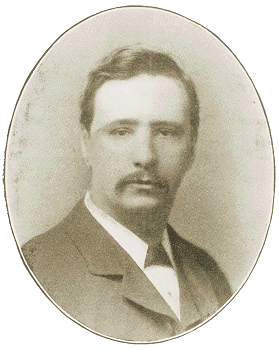
Thomas Parker
|
Mr. Parker presented the Mayoress with a
deerskin blotter, inscribed by the four directors; C. T. Mander,
T. Graham, T. Parker, and W. Thomas. The company then adjourned
to the pattern shop. Speeches were given by Mr. T. Bantock, Mr.
C. T. Mander, Mr. T. Graham and Mr. Brevitt.
Mr. Parker said that he was glad to see Mr.
Bantock present and to know that the Mayor was by his side, upon
whom he looked as a tower of strength in connection with that
undertaking.
The site upon which those buildings had been
erected was a field in July last. The idea of starting those
works was fixed upon by the gentlemen who formed his staff, who
about nine years ago came to Wolverhampton as pupils to him at
the works of Elwell-Parker, Limited, and had grown with and
taken a large part in carrying out the works that made the name
of Elwell-Parker known throughout the world. |
| They had been his staff through the term of his
agreement and of service with the Electric Construction
Company, Limited, as their engineer and works manager.
They made the term of further union to be the initiation
of a new concern. They now gave Thomas Parker, Limited,
their united services and experience, and had each
subscribed largely to its capital. He wished them to
receive from the friends of the firm credit for this.
|
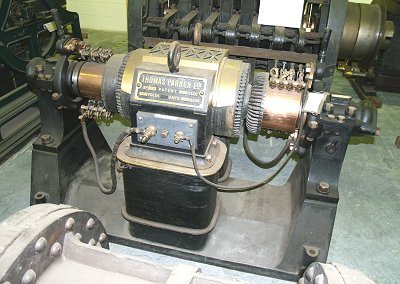
| The Thomas Parker
rotary converter at the Museum Collections
Centre, Duddeston, Birmingham. |
|
|
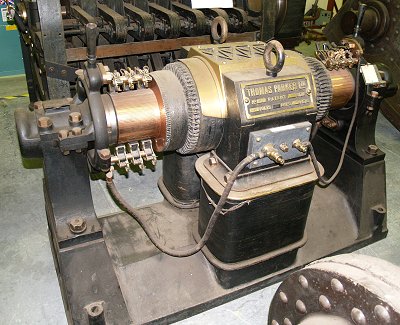
Another view of the rotary
converter. |
By inviting the Mayoress and their friends there
that day, to see their progress, they wished them to see
they were in real earnest. Of their buildings they
would be able to judge, and they had plenty of ground
for development. They were now able to take in hand the
largest work which was likely to be required.
They intended to do the higher class of work at the
lowest cost. They had plenty of orders in hand. |
| He had the greatest faith in the greatness of the
future of electrical engineering, where the object was
sound and legitimate business. This, he was sure, was
the one object of the directors. They had been working
upon designs and patterns the last five months, and
hoped to be able to offer the public a better class than
they had bought hitherto, and improved designs. They were
far more advanced than those present were able to judge,
and if they visited the works a month or two hence, they
would see a great change. |
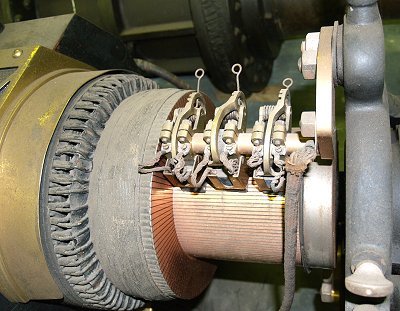
A close-up view of one of the commutators on the above rotary
converter. |
|
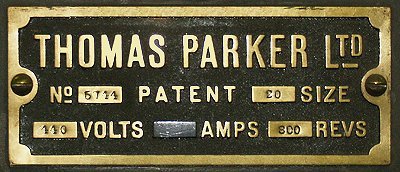
The manufacturer's plate on
the rotary converter. |
|
They could see they were making great
strides. They had obtained some important patent rights, and he
thought the works would be a standing monument to their
chairman, the Mayor, during his Mayoralty.
Electric Lighting at Wightwick Manor
Thomas was friendly with the Mander family and on a visit to
Wightwick Manor in 1895, he suggested that electric lighting
should be installed in the house. The family agreed and the work
was carried out by Thomas Parker, Limited, in 1895 / 96. The
installation consisted of a steam driven generator, which
supplied 100 volts D.C. for the lamps. A set of lead-acid
batteries was added at a later date.
Read a
contemporary account of Thomas
Parker, Limited |

|
| |
|
|
|
The following article appeared in the January 11th, 1895 edition
of 'The Engineer':
Continuous
Current Hinged Pole Piece Dynamo.
Messrs. Thomas Parker, Limited, Wolverhampton, Engineers.

In the dynamo illustrated above one of the
special features is the cutting through of the pole pieces, and
hinging these so that they can be turned back to allow of the
examination, or taking out of the armature by a direct vertical
lift, and without upsetting the bearings. The hinge is placed at
the angle of the pole piece, so that when turned back halfway,
the magnet ferrule can be lifted off, after the armature has
been removed, without uncoupling the hinged piece. This
arrangement allows of machines being fixed in confined spaces,
which would not be suitable with the ordinary type of machine,
where the armature has to be threaded in to or out of the
magnets. There is also considerably less risk of damage in
withdrawing or replacing the armature.
There is an oil well in the pedestal
underneath the bottom of the bearing, the bottom bearing being
continuous; a ring runs in this well and over the top of the
shaft, giving continuous lubrication. Where machines are coupled
direct to high speed engines, the armatures are at the bottom,
the pole pieces in this case also being cut through, so that the
upper portion of the magnets can be lifted away, and the
armature then lifted out.
With these new arrangements, the putting in
or taking out of an armature is much more simple, and occupies
far less time than is required by the old method. All armatures
are coil wound under the Eickemeyer patents. |
|
|
Second Annual
Meeting
The annual meeting of the directors and
shareholders for 1895 was held at the works on Wednesday, 31st
July, 1895. The Mayor, Mr. C. T. Mander, presided and amongst those present
were Mr. T. Parker, Managing Director, W. Thomas, Richard
Armistead, Giles Atherton, representing Rudolf Eickemeyer,
Armistead jnr., Woodward, Iles, J. E. Underhill, Rees, M. Wilkie,
and H. P. Smith. |

This excellent example of a Thomas Parker
dynamo can be seen at the Black Country Living Museum, Dudley. |
The Chairman said that the company was only formed
in April 1894 and they had only commenced work at the end of
January, and not much had much happened before the middle of
March. The balance sheet practically referred to only five or
six week’s trade and their invoices for the month of July were
50 percent more in value than the whole of the trading up to
April last.
In June 1894 they started with a workforce of just 3 men and
now they were employing 268.
They should be able to wipe off their debt at the bank and spend
more money on buildings, machinery and tools. |
| At present they had most admirable machinery,
capable of turning out the largest dynamos etc., but they wanted
offices, another smith’s shop, another bay to their main works,
and they would then be able to turn out double the present
amount of work. They had orders on the books amounting to over
£24,000, so that they would be turning out a lot of work and had
every prospect of doing a sound and prosperous business. |
| Mr. Parker, in seconding, expressed the pleasure
it gave him to see the shareholders inspecting the works and
noting how they were going on. They did not start a business;
they had had to start to build up a business, and that, they had
been successful in achieving. Their turnover at the present time
would make them a profit on the capital, and if they got further
money, which they hoped to do, they would with a very slight
outlay in buildings be able to double the output of the place,
and so double, in his opinion, the value of the share capital.
They could readily have any amount of orders; their difficulty
was in being able to execute them. |
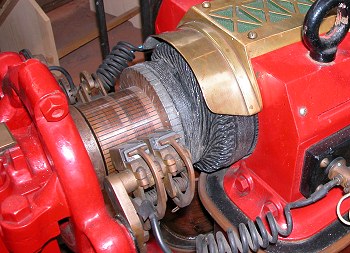
A close up view of the commutator and
armature on the Thomas Parker dynamo at the Black Country Living
Museum, Dudley. It shows the high standard of workmanship and
quality of construction, that is typical of a Thomas Parker
product. |
|
The works might look a trifle straggling,
but they had been so laid out as to bring in a siding from
either the Great Western or the Midland. The balance sheet was a
small one, but it showed a good beginning. Today they were
making a dividend, and he thought the shareholders would agree
with him that they had established a good business, they were an
accepted fact in the electrical world, their goods were selling,
and that altogether they had done even better than anticipated
under the circumstances. A year hence, and he expected they
would go away from the annual meeting thoroughly well satisfied.
The Order Book
Thomas Parker, Limited, like most other
similar concerns at the time relied on orders from municipal
authorities. The £24,000 mentioned in the 1895 Chairman's report
included an order from Wolverhampton Council for dynamos etc.
for their new power station and electrical distribution system.
| Read about
Wolverhampton's first power station. |

|
A Disappointing
Future
The annual meetings always took place at
the registered offices in Wednesfield Road. Although the
directors looked forward to a successful future, it was not to
be, as can be seen from the dividend records:
| 1895 |
No dividend mentioned |
| 1896 |
5% dividend |
| 1897 |
7% dividend |
| 1898 |
8% dividend |
| 1899 |
10% dividend |
| 1900 |
10% dividend |
| 1901 |
10% dividend. The directors say that they
are trying to get a quotation from the London Stock
Exchange. |
| 1902 |
10% dividend |
| 1903 |
6% dividend. |
| 1904 |
No dividend mentioned |
| 1905 |
No dividend mentioned |
| 1906 |
No dividend mentioned |
| 1907 |
No dividend mentioned |
| 1908 |
No dividend mentioned |
| 1909 |
Company wound-up |
At the 7th annual meeting, on Monday, 8th
July, 1901, the Chairman said that there was no need for much
comment on his part and they proposed to pay a dividend of 10
percent, to which he did not think the shareholders would
object. Mr. Elton, a shareholder, observed that the company had
made £3,000 less profit than last year, and £3,000 less than the
year before, making it £6,000 in two years. In the same period,
some thousands more debentures had been borrowed. If that was a
small company, and they went on at the same rate, they would
soon be in the hands of the debenture owners alone.
Thomas Parker was a benevolent employer as
can be seen from the following article that appeared in 'The
Engineer' on the 4th September, 1896.
| At the works of Thomas Parker, Limited,
electrical engineers, of Wolverhampton a
re-arrangement of hours has just come into
operation. Instead of starting each morning at 8
a.m. and leaving at 6 p.m., with an interval for
dinner, the works will in future be open from 6
a.m. till 5 p.m., and an hour and a half will be
allowed for meals, whilst the closing hour on
Saturdays will be noon instead of 1 p.m. |
|
Unfortunately the reduced hours did not
have the desired result, as can be seen from a letter that
Thomas sent to Mr. Hulse, of Messrs. Hulse and Sons, Manchester.
|
Thomas explained that the
reason which influenced the firm in trying a
forty nine hours week when they started the
works, towards the end of 1894, was a wish to
fall-in with the general desire which seemed to
exist that shorter hours should be conceded to
mechanics if possible, and the circumstance that
the Government had conceded the eight hours in
certain of their engineering departments was
also not without its efforts. As time went on,
however, the firm was disappointed with the
results. The men showed no desire to assist the
firm in anyway out of regard for the great
concession which bad been made them, and there
was just as much time wasted as under a fifty
three or fifty four hours week.
Further, the men, especially as their number
grew with the extension of the firm's business,
showed a distinct dislike to continue working to
six o'clock, and would have preferred to stop an
hour earlier, as is the rule under the present
changed condition of things. At the present time
the men begin work at six o'clock a.m. and leave
at five in the evening, taking out half an hour
for breakfast and an hour for dinner for five
days in the week, and on Saturday stop at noon,
thus making a fifty three hours week. |
|
The short week was abandoned after the
failed experiment, and the union instantly made a demand for
increased wages, which the company refused to pay. The outcome
of the dispute is not known, but it resulted in Thomas Parker
having a great dislike of the extremes of trades unionism. At
the time of the dispute the number of employees had increased to
over 400.
In 1897 / 98 the company made the
generators for the Folkstone Electricity works, which opened in
1898. They produced 3,000 volts D.C., which was stepped-down at
sub-stations, using rotary converters. The system operated until
1923.
|
A
visit by members of the Institution of
Mechanical Engineers in 1897 to Thomas
Parker Limited
These works are situated on the
Wednesfield Road, within five hundred
yards of the railway stations. They were
built in the latter part of 1894, and
some extensions have recently been made.
They comprise in independent buildings;
iron and brass foundries; pattern
makers' and smiths' shops; and the main
shop, 250 feet long by 150 feet wide, in
which are the machine tool, erecting,
winding, and testing departments; and
stores. The offices adjoin the main
shop. The whole of the works including
the power cranes are driven
electrically; and the lighting by arc
and incandescent lamps is also supplied
from the same generating plant. Most of
the machine tools are driven from line
shafting; but some lately added, have
their own motor. The works are employed
solely in the manufacture of dynamos,
motors, and switch gear, etc. and
furnish complete equipment for electric
lighting, electric railways, tramways,
and power transmission. The number of
workpeople at present employed is about
400. |
|
On 2nd August, 1899, the Express
& Star reported that Mr. T. Parker, the founder of the business,
had relinquished the position of managing director, but retained
his seat on the Board of Directors. In addition the company had
retained his special services in the way of advice, by
appointing him consulting electrical engineer. Also in 1899
Thomas developed a method of manufacturing Chlorate of Soda
using a version of his "Wednesfield Furnace".
|

Thomas Parker and his favourite dog,
Bruce. Courtesy of Gail Tudor. |
Large scale electricity distribution became
a reality in South Staffordshire with the formation of the
Midland Electric Corporation in June 1897. Thomas Parker was the
creative genius behind the venture and the Corporation’s
chairman was Wolverhampton engineer, J. F. Allbright. In 1898 it
was granted Provisional Orders to supply a number of the local
towns, including Bilston, Brierley Hill, Cradley Heath,
Darlaston, Kingswinford, Old Hill, Tipton, Wednesbury and
Willenhall.
The M.E.C. was the first company to get Statutory
powers to distribute electricity over such a large and varied
area. A power station was built on 14 acres of land at Ocker
Hill to supply the power. It was near to a coal mine and by the
side of the Birmingham Canal Navigation. Sub stations were built
at Bilston, Brierley Hill, Darlaston, Old Hill, Tipton and
Wednesbury. Some local councils including Tipton and Wednesbury
decided to distribute the power themselves, whereas others left
it to the Corporation.
|
| An article from 'The Engineer', 17th
February, 1899:
Enclosed Type Motors
The enclosed type of motor is
gaining ground, especially for use in confined
situations, or in places such as
engineers' and other shops, where bits of iron,
steel, or like substances, might fall on the
armature, and for
crane work. The original difficulty with enclosed
motors was undue heating, but this, with improved
designs, has been entirely overcome.
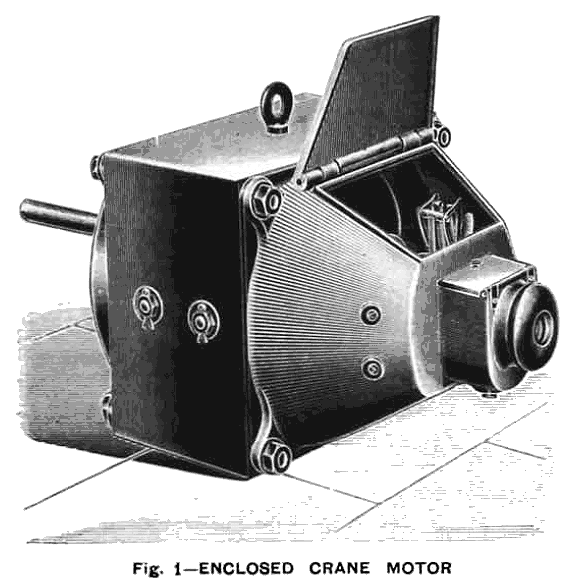
Our illustrations show two motors made by Messrs.
Thomas Parker, Limited, of Wolverhampton. Figs. 1
and 2 show the motor generally used by this firm for
driving cranes or for machinery where floor space is
a consideration, the motor in this case being either
hung to the machine it is driving or placed upon a
bracket on the wall, if shafting is being driven.

It will be seen that the motor used is of the
horizontal two pole type, arranged so as to
economise space to the utmost. The pole pieces are
of a somewhat peculiar shape, and are bolted to the
side of the motor box. In the interior view, Fig.
2., a liberty has been taken with the drawing, the
brushes being shown as they are when at work,
although,
as a fact, they are fixed to the end cover, and
would have been taken away when this was removed.
This end cover is provided with a lid which can be
lifted for the inspection of the commutator and
brushes. The brushes are of the carbon block type,
the carbon being kept against the commutator by
means of springs and levers as shown. The weight of
the motor complete in its case is 11½
cwt., and its normal consumption is about 220 volts
and 30 amperes at 500 revolutions per minute.
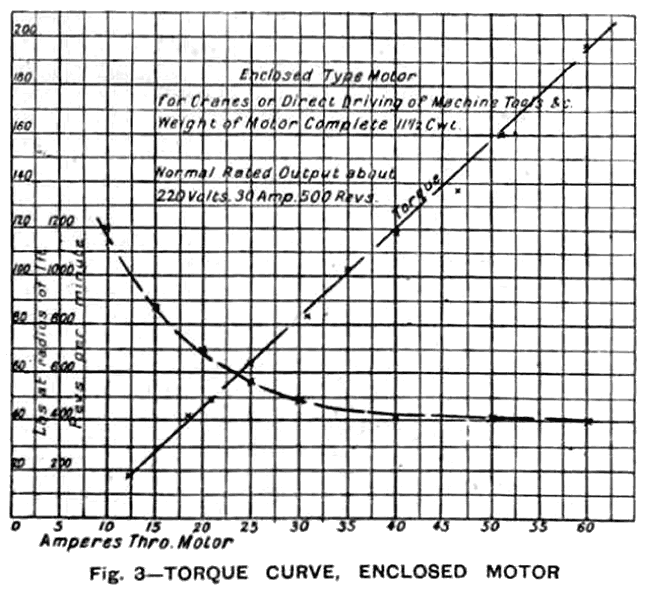
Fig. 3 shows a torque curve of this motor. It
will be seen that at its normal rated point, 30
amperes, the torque is equal to 83lb. at a radius of
1ft. At 60 amperes the torque is no less than 197
lb. at 1ft. The armature,
as is the case with all Messrs. Parker's machines,
is wound with the patent Eickemeyer coils. For
ordinary shop work, such as the driving of shafting
by belts, or for coupling direct, another class of
enclosed motor is used. Figs. 4 and 5 show Messrs.
Parker's iron-clad motor.
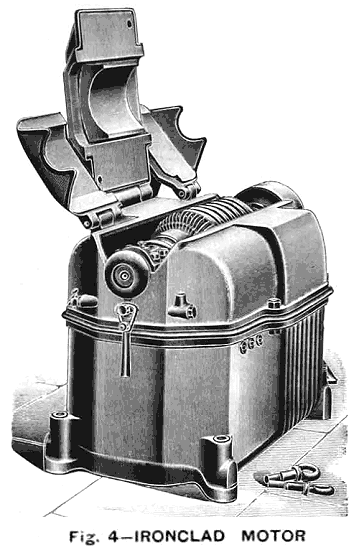 |
In this machine no moving part, with the
exception of the pulley, is uncovered. This
is a useful point when it is desired to have
the motor running in such a position
that small tools or bits of metal might fly
into it.
The motor is provided with a hinged top,
part of this top forming one of the pole
pieces. When this is laid open it is easy to
remove the armature, and the bearings can be
got at for oiling by means of the smaller
covers at either end. The coolness with
which this motor runs is remarkable.
The temperature inside the box is but
little in excess of what it would have been
had the machine been running without its
covering. No doubt this is due to the design
and winding of the motor, and the ribs on
the outside assist in the dissipation of the
heat. This type of machine is used by
Messrs. Parker in their own shops for
driving shafting, machine tools, etc., and
they appear to give great satisfaction. The
brushes are of the same type as in the crane
motors, and seem to run with practically no
attention. |
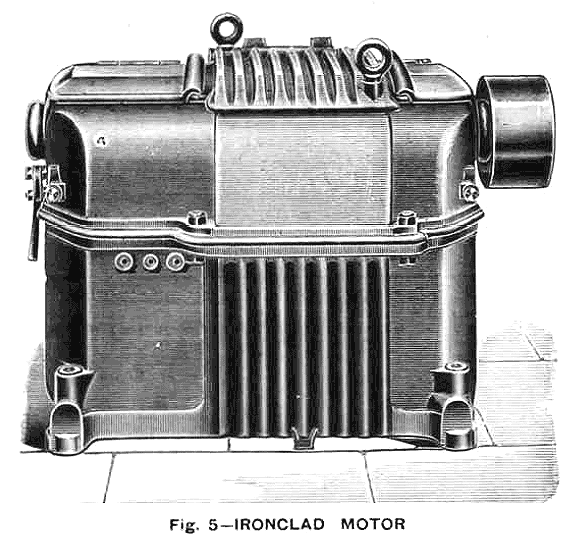 |
|
|
An article from 'The Engineer',
17th March, 1899:
The Electric "Buff"
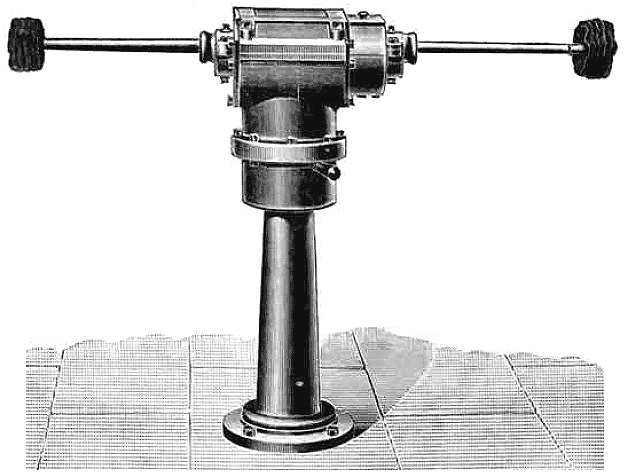
The Electric "Buff" or bob motor, shown in the
accompanying illustration, has been designed and
patented by
Messrs. Thomas Parker, Limited, of Wolverhampton,
for polishing silver plate for hotels and ships.
Larger sizes
made in the same way are intended for buffing
brasswork during construction. The small two pole
motor, and the
starting and regulating switch, are fitted inside
the pillar, as also is the regulating resistance, so
that the whole thing is
self contained, and only requires the two main wires
bringing to it. The bearings and commutator are dust
proof, so that none of the material used in
polishing can get into, and damage them. |
|
| An article from 'The Engineer', 5th May,
1899:
A New Variable Ratio Transformer
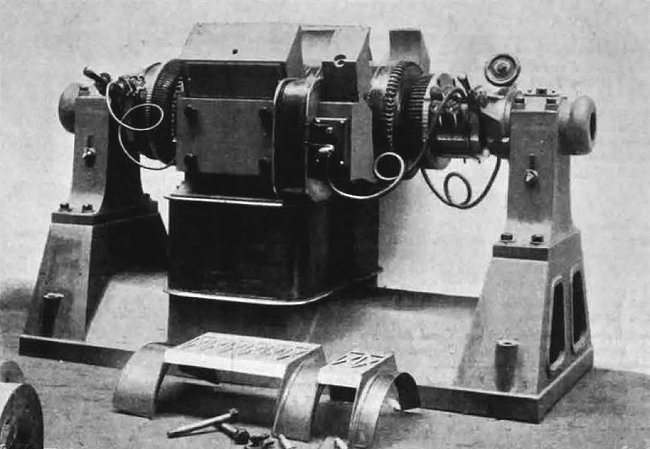
Fig.1. Variable ratio transformer.
Our illustrations show a new
form of variable ratio direct current transformer,
three of which have recently been made
by Thomas Parker, Limited, of Wolverhampton, for the
lighting of Bromley and Chiselhurst. These are the
first of
this type which have been built, and we understand
that the tests have come out very well. The
transformer in Fig. l is shown with its hinged pole
pieces opened so that the armature is easily lifted,
which is extremely useful for such things as
transformers, which frequently have to be placed in
confined situations with none too much head room.
The novelty about this particular type is the
arrangement of the auxiliary or regulating pole
piece, which, instead of springing from the
bed-plate, as has hitherto been customary, is made
by an extension of the main pole piece.
The main field, or a portion of
it, is therefore diverted into the auxiliary pole
pieces, thus minimising the reaction of these
independent pole pieces. The armature is wound as
shown in Fig. 2, and has two cores. In the ordinary
transformer, with two sets of coils wound on one
core, any alteration to the field acts on both
windings equally, so that if it is required to
compensate for a drop of electromotive force in long
lengths of feeders, it is necessary to insert a
resistance in series with either the high tension or
the low-tension winding. In the transformer in
question the larger core has one winding complete,
the evolutes or cross connections coming between the
two cores. This is the high-tension winding. The
low-tension winding comes outside this, and extends,
in addition, over the smaller core. By thus
extending one set of the armature coils over the
auxiliary core it is possible to add to or diminish
the electromotive force in this particular set of
coils by means of the auxiliary field, without
affecting the other winding, and thus get the
variable ratio.

Naturally it is not always that
the conditions warrant the use of such a machine.
These particular transformers have been built for
Messrs. Edmundson and Co., and the conditions which
have had to be conformed to are as follows:- One of
the machines will either be supplied with
high-tension current at from 2000 to 2100 volts, in
which case it would have to give 420 to 450 volts
and 105 amperes, or with current at 420 to 450
volts, in which case it would give 2000 to 2100
volts and 22 amperes. Thus, when 2100 volts are
applied to the high-tension side, 450 volts are
available at the secondary, and vice versa. This
particular machine, therefore, is either for a
"step-up" or "step-down" transformer.
The other two machines are
intended simply to be supplied with high-tension
current, and are required to give 150 amperes from
420 to 450 volts. The primary electromotive force is
to vary from 1900 to 2000 volts, but the machines
are required to give their full output at 450 volts
with only 1900 volts at the primary when running at
600 revolutions per minute. |
|
|
In some parts of the area, problems arose
due to subsidence from mining. To prevent the cables being
broken, "loop pits" were built every 200 yards, each containing
6 yards of slack cable and the cable in between the pits was
enclosed in pipework.
Thomas left Thomas Parker, Limited, in
1904, at the end of his ten year contract, and moved to London
to work for the Metropolitan Railway.
He was a keen advocate of smoke
abatement in industrial areas, and in the same year he
invented 'Coalite', a smokeless fuel obtained by the
low-temperature carbonisation of coal. The retorts for the
production of 'Coalite' were designed by Thomas and produced
at a company that he established near Wolverhampton.
|
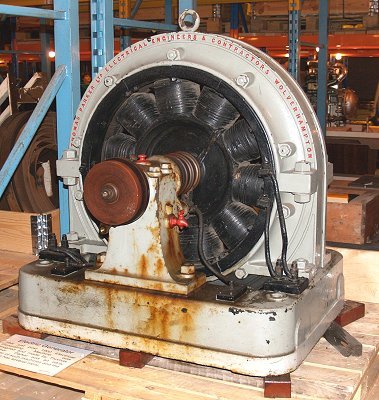
| The Thomas Parker
Alternator at the Museum Collections Centre,
Duddeston, Birmingham. |
|
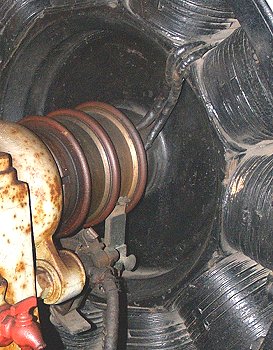
| A close-up view of
the above alternator showing the revolving
field coils and the slip rings. |
|
Things continued to get worse for the company as can
be seen in the Chairman's report of 24th July 19057.
The accounts showed an adverse balance caused by lack of
orders. The report concluded that this state of
affairs was general throughout the electrical trade in
England and was brought about by the general bad trade
of the country, combined with the large amount of
capital which had been sunk into the industry during the
last few years, and large new works which had been
built, leading to new extensions in the old works, to
meet the competition.
In 1896 the total capital invested in electrical
works in England was about £2,000,000, whereas at the
present time it was nearly £12,000,000, and it had
doubled even since 1900.
During the previous year they had reduced the
workforce and had gone on short time; however during the
previous two months they had returned to full time. |
| An advert from the 'Electrical
Review', March 1905. |
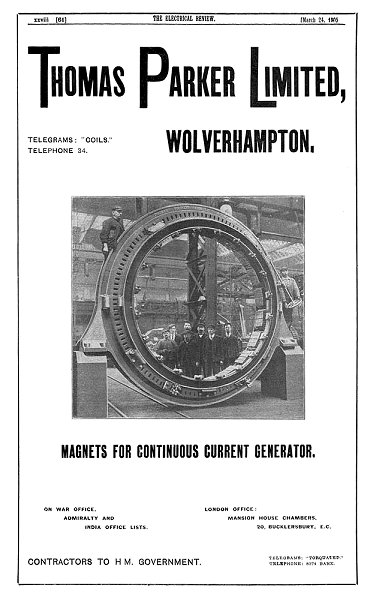 |
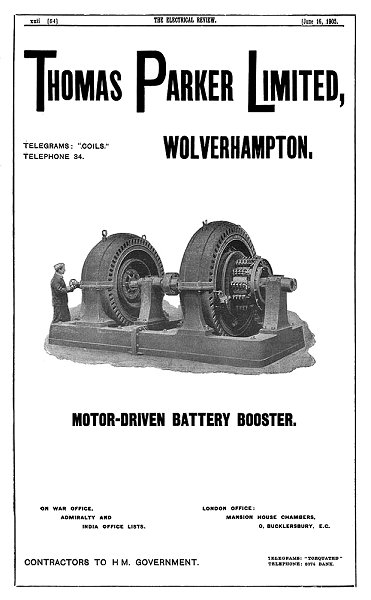 |
An advert from the 'Electrical
Review', June 1905. |

An example of what appears to be one of the
company's later products, a
¾hp. 100volt DC motor. Courtesy of Simon Bosworth. |

Two high tension, DC dynamos made
by Thomas Parker Limited and installed in Hull
Corporation's electric lighting station in 1900. The
dynamos are directly coupled to compound steam engines
made by W. H. Allen, Son & Company of Bedford. From 'The
Engineer'.
|
|
Wolverhampton Journal, November 1906
A company has just been registered with a
capital of £30,000 in £1 shares, to acquire from E. S. G. Rees
and Thomas Parker, Limited, the benefit of certain existing
inventions relating to centrifugal turbine and similar pumps.
To
adopt an agreement with the said vendors, and to carry on the
business of pump manufacturers, iron workers, founders,
smelters, smiths, engineers, ironmasters, etc. The subscribers
are C. T. Mander, J. E. Underhill, C. H. Iles, W. Armistead, C.
F. Bekenn, P. B. Down, and E. S. G. Rees. |
|
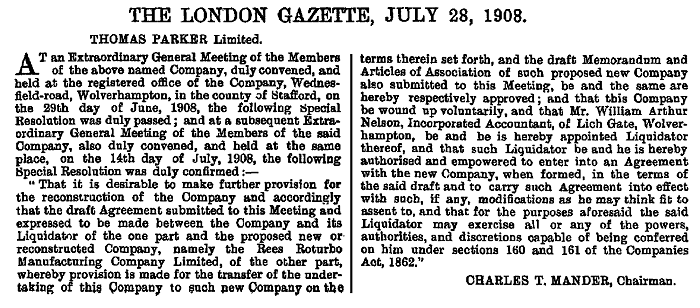
On 14th June, 1908 at
a special meeting, it was decided that the
company would be reconstructed as the Rees
Roturbo Manufacturing Company Limited. |
|
In 1909 the company was wound up after the
directors put it into voluntary liquidation, and transferred all
the assets to the Rees Roturbo Manufacturing Company Limited,
which survived until about 1936.

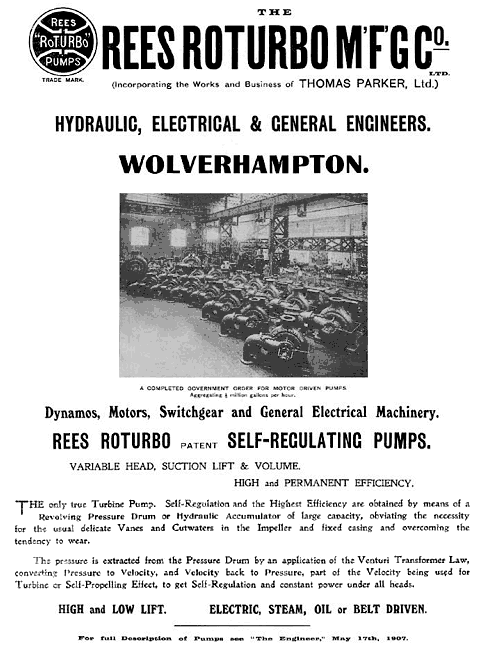
An advert from 1909.

An advert from 1909.
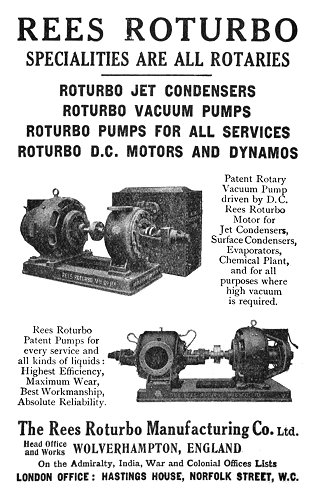 |
Edmund Scott Gustave Rees
(1861-1930) was born in Ghent, but soon afterwards
the family returned to England and lived in
Manchester. He worked for Thomas Parker Limited, and
invented the 'Roturbo' pump.
Around 1936 Rees Roturbo went out of business,
and the factory was acquired by machinery
manufacturer, Joshua Bigwood & Sons Limited.
The factory continued
in use until Bigwoods closed in the early 1980s, when the the
buildings were demolished to make way for an industrial estate. |
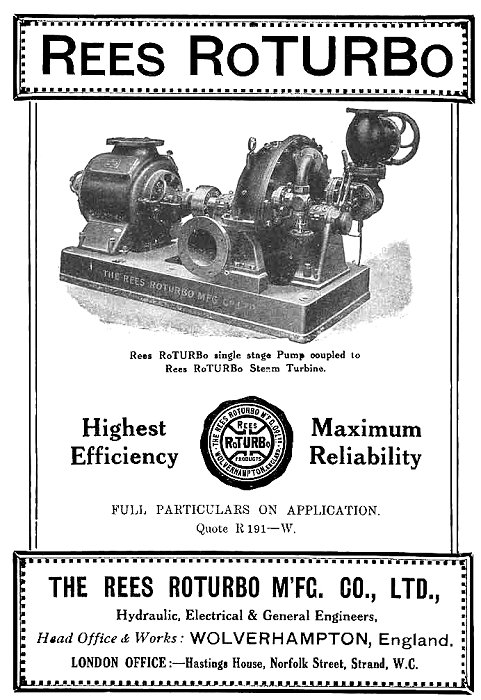
|

|
|

|
|

|
Return to the
General Election |
|
Return to the beginning |
|
Proceed to the
Metropolitan Rlwy |
|
|